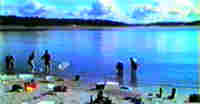|

They
are wonderful
|
|
Suspension feeders dominate amongst the
larger animals on wave exposed beaches, deposit feeders are common on
the more protected beaches. It is seldom that individual animals are totally
specialised - quite often they are capable of attaining food in several
ways.
Food web
Because large plants often cannot survive
on a beach, most of the organic material is produced by microscopic algae.
Much of the organic material that organisms eat originates either from
the sea or further up the beach.
Living organisms come to the beach and are preyed upon,
for example, insects, fish
and plankton, but quite often food appears in the form of decaying animal
and plant debris. Different beach inhabitants can then consume these sources
of food in the form of free organic material, small suspended particles
in the water, washed up carcasses or plants that have lost their foundation.
Carcasses can compise of, amongst other things, jellyfish,
shellfish, mussels and fish. Plant material can comprise of weed,
eelgrass
or seaweed. The small suspended particles can comprise of living or dead
plankton, the left-overs (uneaten remains) from other animals and faeces.
Soluble material can comprise of urine, mucus and organic matter that
can leak out of plankton organisms in large quantities. Certain of these
food sources can be temporary and uncertain, like carcasses and washed
up plants. More scattered and nearly always present - at least in small
quantities - are the small suspended particles and soluble material.
Here, you can see a simplified picture
of how energy and food material flow between the different organisms on
a sand beach. The arrows point to the most important flows, but naturally
an exchange takes place between all the ovals. The ovals even contain
their own, internal food web. New organic material is created almost solely
of microscopic algae. Therefore the import from the land and sea to the
beach area is important.
|

|
Page 10
of 15
|

|
|